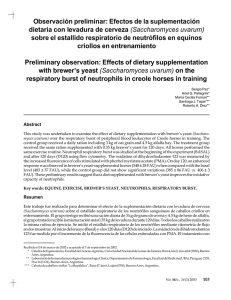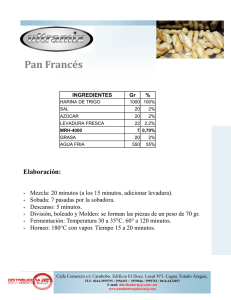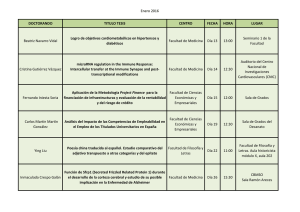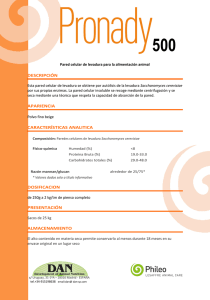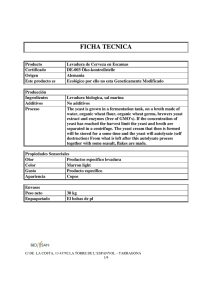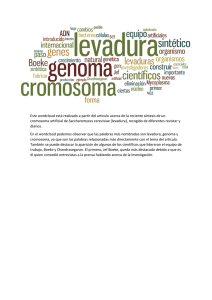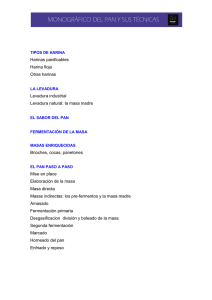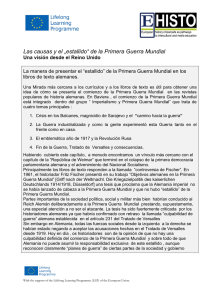Observación preliminar: Efectos de la suplementación dietaria con
Anuncio
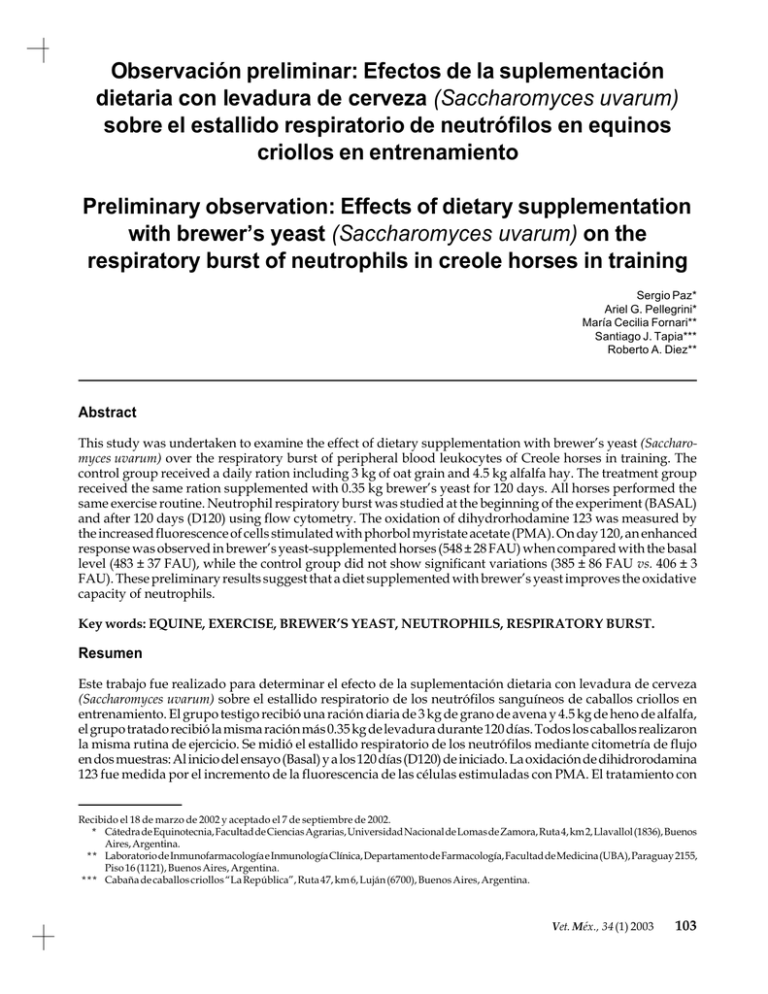
Observación preliminar: Efectos de la suplementación dietaria con levadura de cerveza (Saccharomyces uvarum) sobre el estallido respiratorio de neutrófilos en equinos criollos en entrenamiento Preliminary observation: Effects of dietary supplementation with brewer’s yeast (Saccharomyces uvarum) on the respiratory burst of neutrophils in creole horses in training Sergio Paz* Ariel G. Pellegrini* María Cecilia Fornari** Santiago J. Tapia*** Roberto A. Diez** Abstract This study was undertaken to examine the effect of dietary supplementation with brewer’s yeast (Saccharomyces uvarum) over the respiratory burst of peripheral blood leukocytes of Creole horses in training. The control group received a daily ration including 3 kg of oat grain and 4.5 kg alfalfa hay. The treatment group received the same ration supplemented with 0.35 kg brewer’s yeast for 120 days. All horses performed the same exercise routine. Neutrophil respiratory burst was studied at the beginning of the experiment (BASAL) and after 120 days (D120) using flow cytometry. The oxidation of dihydrorhodamine 123 was measured by the increased fluorescence of cells stimulated with phorbol myristate acetate (PMA). On day 120, an enhanced response was observed in brewer’s yeast-supplemented horses (548 ± 28 FAU) when compared with the basal level (483 ± 37 FAU), while the control group did not show significant variations (385 ± 86 FAU vs. 406 ± 3 FAU). These preliminary results suggest that a diet supplemented with brewer’s yeast improves the oxidative capacity of neutrophils. Key words: EQUINE, EXERCISE, BREWER’S YEAST, NEUTROPHILS, RESPIRATORY BURST. Resumen Este trabajo fue realizado para determinar el efecto de la suplementación dietaria con levadura de cerveza (Saccharomyces uvarum) sobre el estallido respiratorio de los neutrófilos sanguíneos de caballos criollos en entrenamiento. El grupo testigo recibió una ración diaria de 3 kg de grano de avena y 4.5 kg de heno de alfalfa, el grupo tratado recibió la misma ración más 0.35 kg de levadura durante 120 días. Todos los caballos realizaron la misma rutina de ejercicio. Se midió el estallido respiratorio de los neutrófilos mediante citometría de flujo en dos muestras: Al inicio del ensayo (Basal) y a los 120 días (D120) de iniciado. La oxidación de dihidrorodamina 123 fue medida por el incremento de la fluorescencia de las células estimuladas con PMA. El tratamiento con Recibido el 18 de marzo de 2002 y aceptado el 7 de septiembre de 2002. * Cátedra de Equinotecnia, Facultad de Ciencias Agrarias, Universidad Nacional de Lomas de Zamora, Ruta 4, km 2, Llavallol (1836), Buenos Aires, Argentina. * * Laboratorio de Inmunofarmacología e Inmunología Clínica, Departamento de Farmacología, Facultad de Medicina (UBA), Paraguay 2155, Piso 16 (1121), Buenos Aires, Argentina. * * * Cabaña de caballos criollos “La República”, Ruta 47, km 6, Luján (6700), Buenos Aires, Argentina. Vet. Méx., 34 (1) 2003 103 levadura aumentó el estallido respiratorio a los 120 días (Basal 483 ± 37 UAF vs D120 548 ± 28 UAF), a diferencia del grupo testigo, que no modificó significativamente esta función (Basal 385 ± 86 UAF vs 406 ± 3 UAF). Estos resultados preliminares sugieren que la suplementación con levadura de cerveza en la dieta de equinos criollos en entrenamiento aumenta la capacidad oxidativa de los neutrófilos sanguíneos. Palabras clave: EQUINOS, EJERCICIO, LEVADURA DE CERVEZA, NEUTRÓFILOS, ESTALLIDO RESPIRATORIO. ntense exercise has been recognized as a predisposing factor that could change several mechanisms of the immune response in horses,1,2 among them, the functional capacity of neutrophils.3-6 These results have been obtained from horses of different breeds. However, to our knowledge, similar studies have not been performed with the Creole breed. If training induces a similar immune alteration in this breed, the resulting model could be useful for evaluating corrective interventions. Until now, a relationship between exercise, immune response and disease has been difficult to establish because of the complex nature of the immune system and the variety of training procedures employed.1 Recently, nutrition-based attempts have been used to decrease the effect of intense exercise on the immune system of human athletes,7,8 though nutritional recommendations to handle this post-exercise immune defect are based on evidence that is not conclusive.9 In addition, nutritional value of different foods can vary depending on stocking condition,10-12 which poses a significant limitation at the time of making diet adjustments according to calculated requirements. Several factors take place in an exercise-induced immune defect and nutrition is believed to play a critical role. 13 A priori, dehydrated brewer’s yeast presents a wide spectrum of beneficial qualities for horses, including its nutritional value and, probably, additional effects on the immune system. Nutritional components have been the subject of many studies, with emphasis on protein and essential amino acid content. 14 An ill-balanced energy-protein ration is one of the most frequent causes of secondary immunodeficiency.15 Additional mechanisms are less evident, probably depending on structural components of the cellular wall; Saccharomyces cerevisiae and related species stimulate the immune response. The objective of this work was to establish whether exercise and in vivo nutritional supplement with brewer’s yeast could affect the ability of blood neutrophils to perform their main effector activity,16 respiratory burst, with the assumption that such a 104 l ejercicio intenso ha sido reconocido como un factor predisponente que puede alterar significativamente varios mecanismos de la respuesta inmune en los equinos,1,2 entre ellos disminuyendo su capacidad funcional de los neutrófilos.3-6 Estos resultados se han obtenido con caballos de diferentes razas, aunque hasta donde sabemos no se han incluido caballos de raza Criolla. Es probable que el ejercicio realizado por los caballos criollos en entrenamiento produzca una alteración similar de su respuesta inmune, lo que proporcionaría un modelo útil para valorar intervenciones destinadas a modificarla. Hasta el momento ha sido difícil definir una relación entre ejercicio, respuesta inmune, y enfermedad, debido probablemente a numerosos factores, incluyendo la complejidad del sistema inmune y la naturaleza variable de los ejercicios utilizados.1 Recientemente se han realizado intentos en atletas humanos para disminuir los efectos del ejercicio intenso sobre el sistema inmune con base en la nutrición,7,8 aunque todavía las recomendaciones nutricionales para evitar el deterioro posejercicio del sistema inmune se basan en evidencias que no son concluyentes.9 Un componente adicional es que la calidad nutricional de distintos alimentos varía en función de las condiciones de almacenamiento,10-12 lo cual es una dificultad importante al momento de ajustar la dieta a los distintos requerimientos. Son numerosos los factores que influyen en la inmunosupresión inducida por el ejercicio, la nutrición juega un papel crítico.13 La levadura de cerveza deshidratada presenta a priori una amplia variedad de cualidades para los equinos, que abarcan su valor nutricional y, probablemente, efectos adicionales sobre el sistema inmune. El componente nutricional ha sido relativamente bien estudiado, en especial el contenido proteínico y tenor de aminoácidos esenciales.14 La mala nutrición energética-proteínica es una de las causas más frecuentes de inmunodeficiencia secundaria.15 Los mecanismos adicionales son menos claros, probablemente dependen de componentes estructurales de la pared celular de las levaduras:Saccharomycescerevisiae y especies relacionadas estimulan la respuesta inmune. El objetivo de este trabajo fue determinar si el ejercicio y el suplemento nutricional con levadura de cervezainvivo pueden afectar la capacidad de los neutrófilos sanguíneos de generar su principal actividad efectora,16 el estallido respiratorio, asumiendo que tal suplemento podría corre- supplement c ould correct dietary deficiency during training. To this end, flow cytometry was used to evaluate the respiratory burst of peripheral blood neutrophils in horses with or without diet supplementation.17,18 Eight clinically healthy, adult female horses, between six and eleven years old, of the Creole horse ranch, “La República” (Buenos Aires, Argentina), were selected from a group being trained for the 750 km “Endurance Annual March”, which is a fourteen stage event. Two treatments were assigned: one group (CONTROL; n=3) was fed with 3 kg of oat grain and 4.5 kg of alfalfa hay, during the night they were housed in natural pasture grounds. The other group (YEAST; n=5) received the same diet, with an additional 350 g of a commercial brewer’s yeast * preparation. This preparation is obtained as a by-product of beer fermentation. It is composed of heat inactivated and dehydrated Saccharomyces uvarum, approximately 8 × 108 yeasts per gram of dry matter. Following beer fermentation, decantation results in a prewarmed material, which is later concentrated and heat-inactivated, followed by spray dehydration at 360° C. The final product is filtered through 500 µmpore. Both the quality control of the manufacturer and cultures performed in our lab demonstrate that the preparation does not contain viable complete yeasts (<10 UFC/g). Under microscopic examination no impurities are detected. Feeds were administered twice daily; water was available ad libitum. During the study, animals did not show clinical evidence of infection. Whole heparinized blood was drawn from the external jugular vein by venepuncture, in resting condition, before beginning training (BASAL) and after it, at day 120 (D120). Assay of respiratory burst was carried out in a FACSortTM ** cytometer, with acquisition conditions adapted to the leukocyte population to be studied. The cytometer is able to analyze one cell at a time as it flows through the laser (light application stimulation excitation radiation). Up to five parameters can be detect from the cells. Two of these parameters can be detected due to changes in the laser characteristics after cell-laser interaction. The other three are due to laser stimulation of fluorochromes with different emission spectra. Cell size, determined by forward light scattering (FSC), allows the identification and differentiation of cell subpopulations. Internal cell complexity (presence of granules, nuclei and other subcellular structures) was determined by side light scattering, that also allows cell subpopulation identification. gir eventuales carencias en la dieta durante el entrenamiento. Para ello se utilizó la citometría de flujo, evaluando las posibles modificaciones en el estallido respiratorio intracelular de los neutrófilos sanguíneos de equinos.17,18 Se reclutaron ocho equinos adultos (hembras entre seis y once años de edad), clínicamente sanos, de raza Criolla (argentina), pertenecientes a la Cabaña “La República” (Buenos Aires, Argentina), en entrenamiento para la Marcha Anual de Resistencia de 750 kilómetros en catorce etapas. Se asignaron dos tratamientos: El grupo testigo (convencional, n = 3) fue alimentado con 3 kg de grano de avena y aproximadamente 4.5 kg de heno de alfalfa, permaneciendo en potreros de pastizal natural durante la noche. El otro grupo (levadura, n = 5) recibió la misma ración que el grupo convencional, más 350 g de un preparado comercial de levadura de cerveza deshidratada.* Este preparado se obtiene como subproducto de la fermentación de la cerveza, consistiendo enSaccharomucyesuvarum, aproximadamente 8× 108 levaduras por gramo de preparado seco, inactivado por calor y deshidratado. Tras el proceso de fermentación de la cerveza, la decantación produce un material precalentado que se concentra aún más e inactiva por calor, deshidratando por atomización (spray) a 360°C. El resultante así obtenido es pasado por filtro de 500 µm de poro. Tanto el control de calidad del fabricante como el cultivo realizado en el laboratorio demuestran que el producto consiste en levaduras enteras no viables (<10 UFC/g). En la observación microscópica del producto no se detectan impurezas. Las raciones fueron suministradas divididas en dos dosis diarias y los animales disponían de agua a voluntad. Durante el desarrollo del estudio los animales no manifestaron evidencia clínica de infección. Se obtuvo sangre venosa de yugular externa mediante punción de todos los equinos en estado de reposo, tanto al inicio del estudio (Basal) como al finalizar el tratamiento al día ciento veinte (D120). El ensayo del estallido respiratorio se realizó en un citómetro FACSortNR** adecuando las condiciones de adquisición a la población a estudiar. El citómetro de flujo es un instrumento capaz de analizar las células una tras otra, a medida que pasan en una corriente fluida a través de un rayo láser (light application stimulation excitation radiation). De estas células se pueden determinar hasta cinco parámetros. La detección de dos de ellos se basa en el cambio de las características del láser después de interactuar con las células. Los tres restantes son consecuencia de la estimulación que el láser es capaz de producir (en función de su energía) sobre fluorocromos con diferente espectro de emisión. Eltamañocelularpermitediferenciareidentificarsubpoblaciones celulares a través de la dispersión de la luz hacia * Compal S.A., Buenos Aires, Argentina. * * Becton Dickinson, San Jose, California, USA. Vet. Méx., 34 (1) 2003 105 Figura 1. Efecto del suplemento nutricional con levadura sobre el estallido respiratorio de neutrófilos en equinos criollos. Estallido respiratorio de los neutrófilos sanguíneos de equinos tratados con levadura de cerveza o dieta convencional durante cuatro meses. El estallido respiratorio fue medido como oxidación de dihidrorodamina 123 por citometría de flujo. Las barras representan media ± error estándar (mostrado por exceso) del estallido respiratorio. El tratamiento con levadura aumentó el estallido respiratorio a los 120 días (basal 483 ± 37 UAF vs D120 548 ± 28 UAF), a diferencia del grupo testigo, que no modificó significativamente esta función (Basal 385 ± 86 UAF vs 406 ± 3 UAF). El asterisco (*) denota significación estadística tanto contra su valor basal (D0), como contra el valor del grupo testigo al mismo tiempo (D120). Effect of supplement nutritional with brewer’s yeast on respiratory burst of peripheral blood neutrophils in adult Creole horses. Respiratory burst of peripheral blood neutrophils in horses treated or not treated with brewer’s yeast during four month. Respiratory burst detection was performed by flow cytometry measuring oxidation of dihydrorhodamine 123 (DHR-123). Data are expressed as mean ± standard error. An enhanced response was observed in brewer’s yeast-supplemented horses (548 ± 28 FAU) when compared with the basal level (483 ± 37 FAU), while the control group did not show significant variations (385 ± 86 FAU vs 406 ± 3 FAU). * indicates statistical significance both against the basal value and against the value at the same time point (D120). Activation of three different wavelengths, corresponding to different fluorochromes, allow one to evaluate either surface or intracellular antigens, or other molecules, by means of fluorochrome combination. Respiratory burst detection was performed by flow cytometry through the activation of a fluorochrome, dihydrorhodamine 123 (DHR-123), by oxidation mediated by radicals generated during respiratory burst; the active compound, rhodamine 123, is detected as green fluorescence (in FL1). The Burstest *** commercial kit was employed, this uses phorbol myristate acetate (PMA) as a stimulant and DHR-123 as the fluorogenic substrate. Analysis with the appropriated software + allowed the determination of the percentage of cells that had produced oxygen-derived radicals, as well as the extent of radical production by the shift in the fluorescence peak. In each case, the mean value was obtained by reading 10,000 cells; results are shown as mean channel fluorescence, in arbitrary fluorescence units (AFU). Results were statistically analyzed with independent or paired Student’s t test, as appropriate. 106 adelante (Foward light scatter, FSC). La complejidad del interior celular (es decir, presencia de núcleo, gránulos, etc.) se evalúa mediante la dispersión lateral de la luz (Side light scatter, SSC), que también permite diferenciar morfológicamente subtipos celulares. La activación de hasta tres tipos de longitud de onda, correspondientes a fluorocromos diferentes, permite evaluar antígenos de membrana o intracelulares u otras moléculas, mediante la combinación de los mismos. La detección del estallido respiratorio se realizó aprovechando la oxidación de un fluorocromo (dihidrorodamina 123, DHR-123) por los radicales generados durante el estallido respiratorio, detectada en la banda de fluorescencia verde (FL1). Se empleó el equipo comercial Burstest,* utilizando como estimulante PMA (forbol 12-miristato 13-acetato) y la DHR-123 como sustrato fluorogénico. El análisis con el software apropiado** permitió determinar el porcentaje de células que habían producido radicales derivados del oxígeno, y estimar la magnitud de esta producción mediante el análisis de los picos de fluores* Orpegen Pharma, Heidelberg, Germany. * * Cell Quest TM, Becton Dickinson. Figure 1 shows the variation of respiratory burst in both groups throughout the study. Initially, both groups showed respiratory burst values that fell within the normal range,19 although the treatment group (yeast) showed significantly higher basal levels (approximately 20%) than the control group. Analysis within each of the groups showed that respiratory burst for the yeast-treated group increased during treatment: the value at day 120 was significantly higher than the value at day 0. On the contrary, there was no significant variation in the control group. By treatment day 120, the respiratory burst value of the yeast-treated group was significantly higher than the value of the control group (by 25%). The first feature to analyze is the effect of the training program. Jensen-Waern et al.20 evaluated the effects of a endurance ride on neutrophil function among trained horses. They concluded that both hormonal and metabolic changes occur during a ride, which not only trigger neutrophil activation, but also decrease their functional capacy. One day after the exercise, the chemotactic index and chemiluminescence peak decreased significantly, transiently impairing neutrophil antimicrobial functions.5 During strenuous exercise of horses trained for the International Three-Day-Event a significant decrease in the in vitro phagocytosis and killing rate of yeast cells by blood granulocytes was observed.21 In the same study, other immunologic parameters, such as the phorbol myristate acetate-dependent chemiluminescence in granulocytes and the mitogenic stimulation of blood lymphocytes, remained unchanged. Those results are consistent with ours: in the control group no significant change in respiratory burst was seen during the follow-up. Among other possibilities, training in this study might not have been sufficiently intense so as to affect phagocytic activity during the whole training period. Raidal et al.6 showed that the extent of exercise and training can significantly modify their effect on phagocyte function; moderate exercise can even improve immune competence. The variability among individual values of respiratory burst in our study also support that interpretation. As opposed to the lack of variation under control diet conditions, the addition of brewer’s yeast induced an increase in respiratory burst, that was significant by day 120. This effect could be beneficial for horses, since the oxidative activity of leukocytes contributes to immunocompetence. However, the clinical impact of this increase still needs to be evaluated. This preliminary finding, if confirmed by independent studies, could be of practical importance. Severa l mechanisms could be involved to explain this effect of brewer’s yeast. The most obvious is its cencia en FL1, utilizando el valor de la media obtenida por lectura de diez mil células. Los resultados se expresan en unidades arbitrarias de fluorescencia (UAF). Los resultados fueron analizados estadísticamente por prueba de “t” de Student para grupos independientes o para muestras apareadas, según correspondiera. La Figura 1 muestra la variación del estallido respiratorio de los dos grupos a lo largo del estudio. Al inicio del tratamiento ambos grupos presentaban valores de estallido respiratorio dentro del rango normal,19 aunque de manera importante el grupo tratado con levadura mostró valores basales significativamente mayores que el grupo testigo (en aproximadamente 20%). La comparación dentro de cada uno de los grupos mostró que el estallido respiratorio del grupo tratado con levadura aumentó a lo largo del periodo de tratamiento, siendo el valor del día 120 significativamente superior al del día cero. En cambio, el grupo testigo no tuvo variación significativa de sus valores. El valor de estallido respiratorio del grupo levadura a los 120 días de tratamiento era superior al del grupo convencional (cerca de 25% más alto). Un primer aspecto a considerar es el efecto del programa de entrenamiento. Jensen-Waern et al.20 evaluaron los efectos de una carrera de resistencia sobre la función de los neutrófilos en equinos entrenados para tal fin. Aquéllos concluyen que durante la carrera ocurren cambios tanto hormonales como metabólicos, que no sólo “disparan” la activación de los neutrófilos, sino que también reducen su capacidad funcional. Un día después del ejercicio, el índice de quimiotaxis y el pico de quimioluminicencia disminuyen significativamente, afectando transitoriamente la funcionalidad antimicrobiana de los neutrófilos.5 En equinos ejercitados para la preparación del Evento Internacional de los Tres Días, se observó una disminución significativa en la capacidad de los granulocitos sanguíneos para fagocitar y matar levaduras.21 También señalaron que no hubo cambios en otros parámetros inmunológicos, tales como la quimioluminicencia PMA-dependiente de granulocitos y la estimulación mitogénica de linfocitos sanguíneos. Confirmando esta observación, el comportamiento del estallido respiratorio en el grupo testigo fue similar: no tuvo modificación significativa del estallido respiratorio a lo largo del tiempo de seguimiento. Entre otras posibilidades, es probable que el ejercicio que realizaron los caballos en este estudio no fuera tan intenso como para perjudicar su actividad fagocítica durante todo el periodo de entrenamiento. Raidal et al.6 observaron que la magnitud del ejercicio y del entrenamiento puede variar significativamente el efecto sobre la respuesta de los fagocitos conduciendo, en algunos casos con ejercicio moderado, incluso a mejoría de la inmunocompetencia. La variabilidad en los resultados de estallido respiratorio que hemos encontrado también apoya esta interpretación. Vet. Méx., 34 (1) 2003 107 nutritional value:; there is a clear association between malnutrition, mainly due to a lack of proteins, and immunodeficiency. Though we did not find reports of a relationship between brewer’s yeast, the immune system and infections in horses, this supplement is a source rich in protein and essential amino acid for horses. 14 It also contains amino acid precursors, such as glutamine, that has been shown to be involved in the functional regulation of the immune system. 22,23 Further studies are needed to test this hypothesis, based on the measure of nutritional value of foods and comparing diets with similar energy but different protein content and their relation with the immune response. Besides the nutritional value, an alternative explanation may involve the immunoregulatory ability of yeasts. Several species of Saccharomyces are potent in vitro stimulators of innate immune response, at least in part through the interaction between their surface mannan and mannose receptors on phagocyte membranes. Since innate immunity plays a central role both as an effector and as a regulator of the immune response, this possibility, if correct, could have interesting clinical applications. Such effects could involve yeast activity within the digestive tract, its interaction with resident flora, its relationship with the mucosal immune system, or even distant effects resulting from the systemic absorption of mannose. Though none of these possibilities can be formally excluded, some seem quite improbable. First, due to heat inactivation, brewer’s yeast contains mainly dead cells. Repetitive viability controls performed in our lab did not show colony development, though it is not possible to exclude the survival of a few yeasts. Thus, digestive colonization by Saccharomyces uvarum or its interaction with the resident flora seem improbable. Second, the effect could be associated with leukocyte activation after yeast phagocytosis, under microscopic examination yeasts look complete and easily undergo phagocytosis in vitro. However, passage of complete yeasts across the mucous layer seems unlikely, and thus activation would have to be intraluminal, from phagocytes entering the lumen and somehow generating a systemic response intense enough to modify the oxidative activity of jugular leukocytes. Though possible, this interpretation is unlikely. More probable is some kind of systemic activation of leukocytes, with priming as a result of mannose ab- 108 En contraposición con la falta de modificación en condiciones espontáneas, el suplemento de levadura indujo un aumento del estallido respiratorio, que evaluado al D120 resultó significativo. Esto último probablemente es benéfico para que los caballos mantengan la función oxidativa de los leucocitos, ya que ésta debería contribuir a la inmunocompetencia. Sin embargo, la valoración de su impacto clínico está por documentarse. Este hallazgo preliminar, de confirmarse en estudios independientes, puede ser de importancia práctica. Varios mecanismos pueden estar involucrados en la explicación de este efecto de la levadura. El más obvio podría ser su efecto nutricional: es clara la asociación entre desnutrición, especialmente proteínica, y falta de inmunocompetencia. Si bien no hemos encontrado antecedentes que relacionen de manera directa este aditivo con infecciones ni con las distintas funciones del sistema inmune en los equinos, la levadura de cerveza constituye un suplemento alimentario caracterizado por tener alto contenido en proteínas y aminoácidos esenciales para el caballo.14 Asimismo, contiene otros aminoácidos o precursores, tal como la glutamina, que sí ha sido involucrada en la regulación funcional del sistema inmune.22,23 Para avanzar en esta hipótesis, habría que desarrollar estudios complementarios midiendo el real valor nutricional de los alimentos administrados a los animales (y no meramente calculados a partir de tablas teóricas) y comparar dietas de igual valor calórico pero diferente contenido proteínico, valorando inmunocompetencia. Existen otras explicaciones alternativas especialmente desafiantes, centradas en la capacidad inmunorregulatoria de la levadura, no vinculada a su poder nutricional. In vitro diversos tipos de Saccharomyces, en parte como consecuencia de su contenido en mananos, son potentes activadores de la inmunidad innata, al menos en parte a través de la activación de receptores de manosa en la superficie de los fagocitos. Dado el rol central de la inmunidad innata, tanto como mecanismo efector o en la regulación de la respuesta inmune, la actividad a este nivel podría tener enormes implicancias clínicas. Tales efectos podrían involucrar la actividad de la levadura dentro del tubo digestivo, su interacción con la flora, su relación con el sistema inmune a nivel de la mucosa, o incluso efectos a distancia, resultantes de la absorción sistémica de la manosa. Si bien ninguna de estas posibilidades puede ser formalmente excluida, algunas parecen poco probables. En primer lugar, el preparado de levadura consiste fundamentalmente en células muertas, como consecuencia de la inactivación por calor. Ninguno de los controles de viabilidad realizados en nuestro laboratorio arrojó desarrollo de colonias, aunque es imposible excluir en forma absoluta la sobrevida de alguna levadura. En estos términos, la colonización digestiva por Saccharomyces uvarum o su interacción con la flora residente parecen poco probables. sorption or other Saccharomyces immunoregulatory components. Digestive mannose absorption has been demonstrated and characterized among pigs24 and is probably similar among other mammals, including horses. Additional studies searching to correlate mannose absorption and immune function, could be useful to test this hypothesis. In summary, this study confirms that exercise does not reduce respiratory burst of blood neutrophils among horses, and shows, in a preliminary way, that the addition of brewer’s yeast supplement induces a small but significant increase of this function during training. Further studies are required to confirm this observation and to determine the mechanisms involved. Acknowledgements We are indebted to the “La República” horse ranch (Buenos Aires, Argentina) for their invaluable collaboration in field work. Also, we thank Bioalpha S.A. for clinical chemistry of blood samples and Compal S.A. for the provision of brewer’s yeast. This work was partly supported by a grant from the National University of Lomas de Zamora, Argentina (FEPI Fellow Program application # 42,704/98). Referencias 1. Hines MT, Schott HC, Bayly WM, Leroux AJ. Exercise and immunity: a review with emphasis on the horse. J Vet Intern Med 1996;10:280-289. 2. Horohov DW, Keadle TL, Pourciau SS, Littlefield-Chabaud MA, Kamerling SG, Keowen ML, et al. Mechanism of exercise-induced augmentation of lymphokine active killer (LAK) cell activity in the horse. Vet Immunol Immunopathol 1996;53:221-233. 3. Tizard I. Inmunología veterinaria. 4a ed. México (DF): Interamericana-McGraw-Hill, 1994. 4. Van Eeden SF, Klut ME, Walker BAM, Hogg JC. The use of flow cytometry to measure neutrophil function. J Immunol Methods 1999;232:23-43. 5. Wong CW, Smith SE, Thong YH, Opdebeeck JP, Thornton JR. Effects of exercise stress on various immune functions in horses. Am J Vet Res 1992;53:1414-1417. 6. Raidal SL, Love DN, Bailey GD, Rose RJ. Effects of single bouts of moderate and high intensity exercise and training on equine peripheral blood neutrophil functions. Res Vet Sci 2000;68:141-146. 7. Nieman DC. Exercise and resistance to infection. Can J Physiol Pharmacol 1998;76:573-580. 8. Nieman DC. Exercise and immune function. Rec Dev Sport Med 1999;27:73-80. 9. Pedersen BK, Bruunsgaard H, Jensen M, Krzywkowski, K, Ostrowski K. Exercise and immune function: effect of ageing and nutrition. Proc Nutr Soc 1999;58:733-742. 10. Lewis LD. Alimentación y cuidado del caballo. Buenos Aires, Argentina: Inter-Médica SAICI, 1991. 11. Powell DG, Jackson SG. El caballo, salud y cuidados. Zaragoza, España: Acribia, 1994. El efecto podría estar asociado a la activación leucocitaria tras la fagocitosis de las levaduras (que, desde el punto de vista estructural, al microscopio se ven completas y son fácilmente fagocitadas in vitro). Sin embargo, el pasaje de levaduras completas a través de la mucosa digestiva no parece probable, de modo que tal activación, de existir, debería ser intraluminal, por contacto con fagocitos que hubieran salido hacia la luz y que fueran capaces de generar alguna repercusión sistémica de su actividad, como para modificar la actividad oxidativa de los leucocitos obtenidos de la yugular. Esta interpretación, siendo posible, parece también poco evidente. Más probable parece la participación de activación leucocitaria sistémica, con algún grado de primado ( priming) como consecuencia de la absorción de manosa u otros componentes inmunorregulatorios del Saccharomyces. La absorción de manosa desde el tubo digestivo de los cerdos ha sido demostrada y caracterizada24 y es probablemente extrapolable a otros mamíferos, incluyendo equinos. Estudios complementarios apuntando a correlacionar absorción de manosa con función inmune podrían arrojar alguna luz sobre esta posibilidad. En resumen, este trabajo confirma que el ejercicio no reduce el estallido respiratorio de los neutrófilos sanguíneo en equinos y documenta, en forma preliminar, el aumento pequeño pero significativo de esta función por el agregado de un suplemento de levadura de cerveza a su ración durante el entrenamiento. Se requieren estudios complementarios para confirmar esta observación y disecar los mecanismos involucrados. Agradecimientos Damos nuestro especial agradecimiento a todos los integrantes de la Cabaña de Caballos Criollos “La República”, por su incondicional ayuda en las tareas a campo y extracción de muestras, así como al Laboratorio de Análisis Clínicos Bioalpha, S.A., Buenos Aires, Argentina. La levadura de cerveza la donó la compañía Compal, S.A., Hudson, Buenos Aires, Argentina. Este proyecto fue financiado parcialmente por el Programa de Becas FEPI (Fortalecimiento de la Ejecución para Proyectos de Investigación) de la Universidad Nacional de Lomas de Zamora, Buenos Aires, Argentina. 12. Tisserand JL. Alimentación práctica del caballo. Zaragoza, España: Acribia, 1981. 13. Bishop NC, Blannim AK, Walsh NP, Robson PJ, Gleeson M. Nutritional aspects of immunosuppression in athletes. Sport Med 1999;28:151-176. 14. National Research Council. Nutrient requeriments of horses. 5th ed. Washington (DC): National Academy Press, 1989. 15. Ozkan H, Olgun N, Sasmaz E, Abacioglu H, Okuyan M, Cevik N. Nutrition, immunity and infections: T lymphocyte subpopulations in protein-energy malnutrition. J Trop Pediatr 1993;39:257-260. Vet. Méx., 34 (1) 2003 109 16. Pyne DB. Regulation of neutrophil function during exercise. Sport Med 1994;17:245-258. 17. Johannisson A, Grondahl G, Demmers S, Jensen-Waern M. Flow-cytometric studies of the phagocytic capacities of equine neutrophils. Acta Vet Scand 1995;36:553-562. 18. Zielinska M, Fenrych W. The application of a flow cytometric assay for evaluation of phagocytosis of neutrophils. Acta Biochimica Pololonica 1997;44:121-125. 19. Paz S, Fornari MC, Pellegrini AG, Diez RA. Respiratory burst of peripheral blood neutrophils of healthy and infected horses and foals. Sixth International Veterinary Symposium; 15-20 July 2001; Uppsala, Sweden. Uppsala, Sweden: International Union of Immunological Societies, 2001:171. 20. Jensen-Waern M, Lindberg A, Johannisson A, Grondahl G, Lindgren JA, Essen-Gustavsson B. The effects of en- 110 21. 22. 23. 24. durance ride on metabolism and neutrophil function. Equine Vet J 1999;30:605-609. Buschmann H, Baumann M. Alterations of cellular immunoresponse during intensive training of event horses. Zentralbl Veterinärmed [B] 1991;38:90-94. Castell LM, Newsholme EA. The effects of oral glutamine supplementation on athletes after prolonged, exhaustive exercise. Nutrition 1997;13:738-742. Castell LM, Newsholme EA. Glutamine and effects of exhaustive exercise upon the immune response. Can J Physiol Pharmacol 1998;76:524-532. Halaihel N, Gerbaud D, Vasseur M, Alvarado F. Heterogeneity of pig intestinal D-glucose transport systems. Am J Physiol 1999;277:C1130-C1141.
